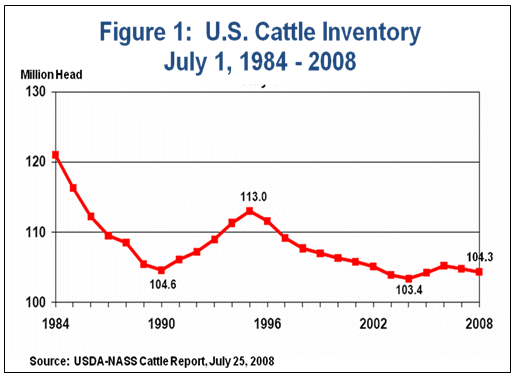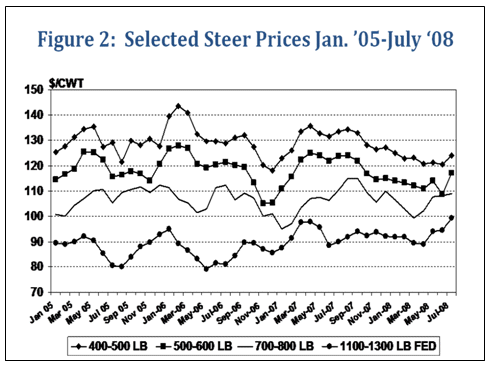AG-ECO NEWS
Vol. 24, Issue 20, July 29, 2008 – PDF version
Jose G. Peña
Texas AgriLife Extension Economist-Management
Mid-Year Cattle Inventory Down Slightly;
High Feed and Energy Costs Keeping a Lid on Prices
USDA’s mid-year cattle inventory report, released on July 25, 2008, indicated that the U.S. cattle herd totaled 104.3 million head, down 500,000 head from the 104.8 million head herd on July 1, 2007, and down about 900,000 head from an inventory of 105.2 million two years ago. (See Figure 1). The report was generally anticipated by the market and appeared to indicate that the industry is in some sort-of limbo with no real signs of expansion or significant indications of liquidation. High production costs, particularly feed costs, a relatively flat to weak market and the continuing drought in a large portion of the southern U.S. influenced the slightly negative inventory change.
Also, related to this, was USDA’s July Cattle on Feed report confirming a continuing decline in feedlot inventories, indicating that feed lots are operating at significantly below capacity. USDA’s July 25, 2008 Cattle on Feed report indicated an inventory of 10.295 million head on feed on July 1, 2008, down 4.1 percent from 10.737 million head on July 1, 2007 and down 5.3 percent from two years ago. Cattle marketings as of the end of June ’08 were down 7.8 percent from a year ago and down 10.2 percent from two years ago. With feedlots operating at significantly below capacity, coupled with high costs of gain, feeder cattle prices are being bid-up at the expense of prices for calves, further discouraging an expansion.
Markets
Cattle markets weakened slightly during spring as corn prices moved to record highs, (See Figure 2), but are showing some improvement as corn prices weaken.
The decrease in the cattle inventory was anticipated by the market. It appears that recent weakness in corn futures prices, dropping over $2.00/bu. from late June highs of close to $8.00/bu. for ’08 contracts and over $8.00/bu. for ’09 contracts is influencing the recent market improvement. Also, USDA’s Cattle on Feed report showing over four percent fewer cattle on feed and close to a nine percent decline in placements in June represented a bullish influence.
While markets have remained relatively strong, the relatively small inventory decrease of the past two years has dropped to just 900,000 head above the current cycle’s inventory low of 103. 4 million head on July 1, 2004. It appears that the cattle industry may be experiencing one of the shortest cycles on record or just treading water, waiting for something to happen, such as more normal rain this fall or lower corn prices. Very tight profit margins as well as the severe 2005-06 drought in the central part of the U.S., and this past fall/winter/spring severe drought in the southern part of the U.S. have had a major influence on the uncertain direction of the industry.
According to Stan Bevers, Professor and Extension Economist, who recently summarized the database of information collected while conducting financial analysis of ranching operations with the Southwest Standardized Performance Analysis (SPA) program, the total cost to maintain a cow in a herd in 2007 was $590.33 per female. This estimate translated to break-even costs of production of $120.82/cwt for calves weaned in 2007. This break-even estimate does not provide much room for profits and financial risk management, in spite of a relatively attractive market.
The 2008 calf crop is estimated at 37.25 million head, down 111,000 head from a calf crop of 37.361 million in 2007 and down 269,000 head from a calf crop of 37.519 million head in 2006. Feeder supplies will remain in short supply unless feeder cattle imports from Mexico increase.
Liquidation?
While the inventory of all cows and heifers that have calved on July 1, 2008, was down 100,000 head from July 1, 2007, the inventory of beef cows at 33.15 million head was down 200,000 head from an inventory of 33.35 million head a year ago. (See Figure 3). The inventory of dairy cows was up 1.1 percent. 
The inventory of beef replacement heifers was down two percent and does not appear to indicate a significant liquidation, however, it does indicate the absence of an inducement to expand the herd. The July 25, 2008 Cattle on Feed inventory includes a slight increase in heifers on feed compared to 2007. Conversely, the inventory of other heifers (feedlot heifers) at 8 million head, remained unchanged from last year. (See Table 1).
Meat Supplies Up
Meanwhile, meat supplies are up, providing consumers a wide variety of choices. USDA’s mid-July ‘08 estimate of red meat production for 2008 (beef, pork, veal, lamb and mutton) at 50.496 billion pounds was up 3.4 percent from 48.817 billion pounds produced last year. Poultry production at 43.257 billion pounds was up 2.7 percent from 42.117 billion pounds produced last year. The July ‘08 estimate of this year’s beef production at 26.668 billion pounds was up slightly from 26.523 billion pounds produced last year. The average live weight for cattle slaughtered was 1,261 pounds, up 11 pounds (0.1%) from average slaughter weights of 1,250 pounds during June a year ago.
Corn Production Down
USDA’s July 11, 2008 supply/demand report pegged the U.S. corn crop at 11.715 billion bushels, down just slightly from last month’s production estimate of 11.735 billion bushels, but down 10.4 percent from 13.074 billion bushels produced last year. Futures prices for corn have weakened significantly during the past 2-3 weeks, influenced by better growing condition after the crop was finally planted.
While futures prices for corn have dropped significantly since late June ’08 highs, cost of gain remain high in relation to the price of calves, feeders and slaughter cattle. High energy (input) costs are expected to continue to have a significant impact on the market.
